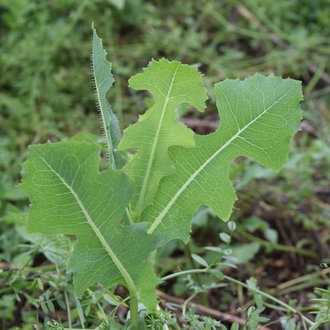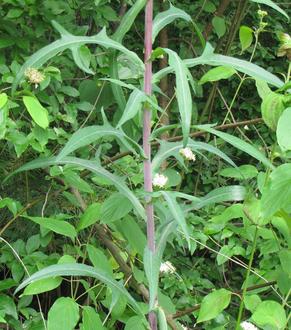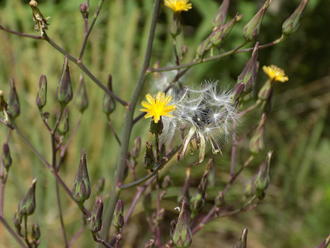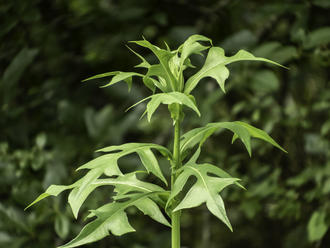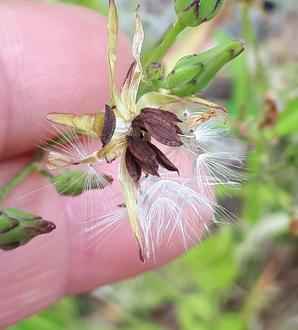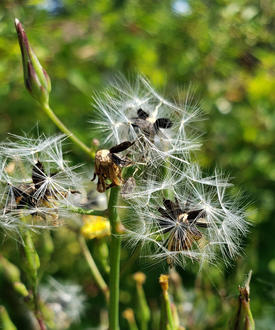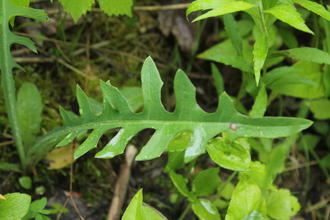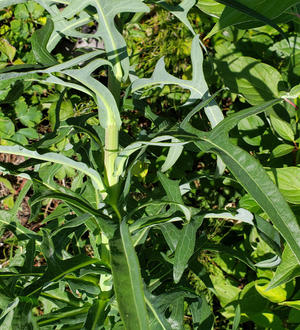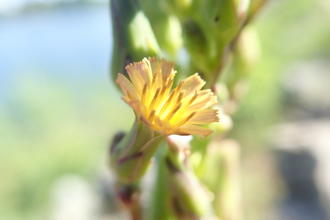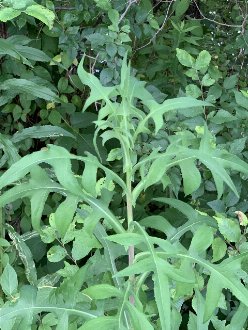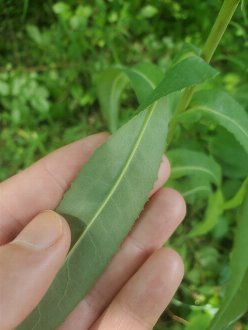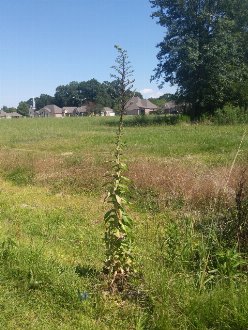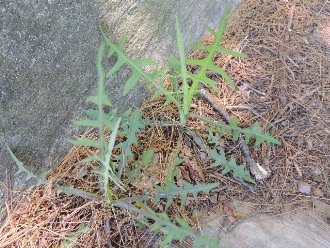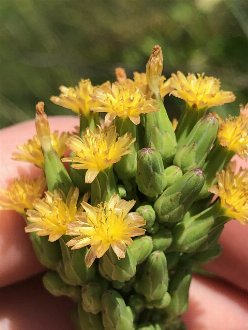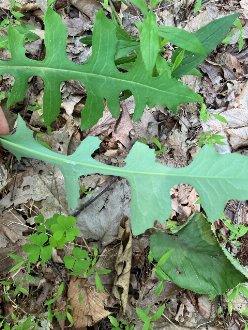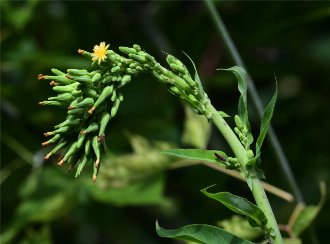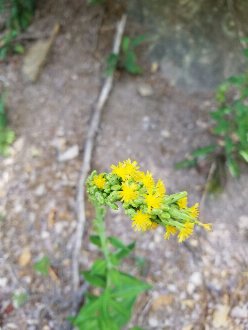American Wild Lettuce (Lactuca canadensis L.)
Also known as Canada lettuce.
↑Summary
A tall biennial native to eastern North America, having expanded its range westward as well.
↑Range - Expand
| Legend | Color |
| Native | |
| Expanded | |
| Native or Not Present | |
| Native or Expanded | |
| Expanded or Not Present | |
| Native or Expanded or Not Present |
This tentative map is based on our own research. It may have limited data on Canada and/or Mexico, and there is some subjectivity in our assignment of plants as introduced vs. expanded. Read more in this blog post.
Although this plant occurs somewhere in each of these regions, it may only occur in a small part of some or all of them.
This is a weedy species with wind-dispersed seeds; it thrives in disturbed and degraded habitats. We marked the new western portions of its range expanded, even though they consist of isolated populations separated by large distances, because this plant is expanding on its own and is not intentionally planted, and because these new populations have established relatively consistently across a large region.
↑Description & Identification
Lactuca canadensis is highly variable in height and leaf shape, which can confound identification. Like most lettuces, it initially grows as a rosette, and second-year plants grow upright with long stems that are usually unbranched until the inflorescence.
It can be distinguished from other lettuces by its flowers, leaf and stem texture and color, and seed characteristics.
↑Similar Plants
↑Habitat
Lactuca canadensis is a common and widely-distributed species that is found in a variety of sunny to partly-sunny habitats that have experienced some disturbance. It is a generalist with respect to soil and moisture conditions, but is adapted to a particular pattern of disturbance where vegetation is cleared from the site in one year, but grows up quickly in the subsequent year. Natural habitats include prairies, savannas, open woodlands, and edges, gaps, or clearings in richer deciduous forests. Anthropogenic habitats include roadsides, railroads. It is often most abundant at the interface between natural and anthropogenic habitats, such as roadsides or paths through partly-wooded areas, powerline clearances, or weedy portions of parks and suburban gardens.
It tolerates a range of moisture conditions from moist to slightly dry, tending to be both more common and more vigorous in slightly moister habitats. It also tolerates a wide range of soil fertility and pH. It usually occurs in loamy to clay-loam soils, but tolerates soil with a significant portion of clay, gravel, or rock. In the southeasternmost portions of its range, especially in coastal areas, it also occurs on sandy soils. It tolerates some degree of salinity, and can occur along brackish marshes and in coastal areas, as well as in areas exposed to winter road salt.
Relative to the native tall blue lettuce (Lactuca biennis) and woodland lettuce (Lactuca floridana), Lactuca canadensis is less tolerant of shade but more tolerant of acidic soils. Relative to hairy lettuce (Lactuca hirsuta), Lactuca canadensis is much more common, but less tolerant of sandy soil and dry conditions. Relative to the introduced prickly lettuce (Lactuca serriola), Lactuca canadensis is more shade-tolerant and prefers moister habitats, is less tolerant of drought and nutrient-poor or thin soils, and, at least in the East, is more likely to occur in natural habitats and less restricted to disturbed and anthropogenic habitats.
↑Life Cycle
Lactuca canadensis usually grows as a biennial, but can grow as an annual when conditions favor rapid growth both for it and competing vegetation.
Plants initially establish as a basal rosette and usually persist only as a rosette through their first growing season. Plants quickly establish a deep taproot, which sometimes has considerable horizontal branches. Basal leaves can be evergreen in mild winters.
Second-year plants rapidly grow upright in spring and flower in summer. The bloom period for a single plant typically lasts 3-4 weeks; individual flowers are short-lived and the plant tends to bloom incermentally, with some seed maturing and blowing away as other flowerbuds are still developing. The bloom period is variable as a function of weather and site; plants on a particular site usually tend to bloom together, but in a broader region, and across many years, the bloom time may be much more variable. If the flowering stems of a plant are top-killed, plants may also bloom later. Although bloom time is variable, this species tends to bloom earlier than other Lactuca species with which it overlaps in range.
Seeds are distributed by wind, have no required dormancy, and often germinate quickly, within a couple weeks of falling.
↑Faunal Associations
This species is browsed heavily by mammalian herbivores, including rabbits, groundhog, deer, and livestock, including horses, cows, and sheep, all of which eat this species in spite of its bitter latex sap. Rabbits are more likely to browse first-year plants, whereas deer are more likely to eat the tips off developing stems. Groundhogs often knock the stems over to eat the developing stems. Herbivore browsing tends to greatly reduce the size and productivity of plants, with lower productivity not only reflected in lower seed count but also greatly reduced seed size, but plants usually survive such browsing.
The flowers are primarily bee-pollinated, and attract a variety of bees including the broad-handed leafcutter (Megachile latimanus). and Lasioglossum lustrans.
The foliage is eaten by the larvae of several moth species, including the chain-dotted geometer (Cingilia catenaria), the moth Kodiosoma fulvum, and four moths of the Noctuidae family. The plant is also particularly good at supporting aphids, with a number of different aphid species feeding on this plant, often in large numbers.
The seeds are occasionally eaten by goldfinches and other finches.
↑Uses
The sap, along with that of other Lactuca species, can be used to produce Lactucarium, a substance with opium-like properties that has seen some medicinal use. However this species is not the primary one used to produce Lactuarium; normally bitter lettuce (Lactuca virosa) is used.
This species is rarely planted intentionally and is often, unfortunately, viewed as a weed because it does not fit conventional Western aesthetics with its short-lived, relatively inconspicuous flowers.
However, within its native range, it has high value to the food web and can be used in ecological restoration projects, where it often competes favorably against invasive plants. Because it is common and weedy, it usually shows up in suitable habitat on its own, and needs little encouragment, so the most important thing to do to utilize this plant is to educate people on how to identify it and on its ecological value, so that they do not remove it.
↑Related Plants
Within the Lactuca genus, this species is thought to belong to a clade including six other species native to North America. Their exact relationships are not known, but in general, this species is thought to be closer-related to L. biennis, grassleaf lettuce (Lactuca graminifolia), prairie lettuce (Lactuca ludoviciana), and L. hirsutis, whereas the also-native woodland lettuce (Lactuca floridana) is next-most-closely related. After these species, it is probably next-closest related to Lactuca watsoniana, which is endemic to the Azores and does not occur here, followed by Lactuca plumieri which is native to Western Europe and also does not occur here.
All other Lactuca species in North America, which are all introduced, are less-closely related, and more-closely-related to each other: prickly lettuce (Lactuca serriola), willowleaf lettuce (Lactuca saligna), bitter lettuce (Lactuca virosa), and garden lettuce (Lactuca sativa). These relationships may explain why native insect specialists mostly move interchangeably between the native lettuces but are less likely to eat any of the introduced species, a pattern that is common, but not universal, within plant genera.
↑Notes
Although the common name "Canada Lettuce" is more widely used, we prefer the name "American Wild Lettuce" because this species' native range extends south the whole way to the gulf coast. Although many sources refer to this species only as "wild lettuce", we caution against using this name without the descriptor "American", as many different species in this genus are referred to with this name, including prickly lettuce (Lactuca serriola), woodland lettuce (Lactuca floridana), and prairie lettuce (Lactuca ludoviciana).
↑Links & External Resources
• Lactuca canadensis (Wild Lettuce) | Illinois Wildflowers (About This Site)
• Lactuca canadensis (Canada lettuce) | USDA PLANTS Database (About This Site)
• Lactuca canadensis | Go Botany (About This Site)
• Canada Wild Lettuce | iNaturalist (About This Site)
• Lactuca canadensis | Biota of North America Project (BONAP) (About This Site)
• Lactuca canadensis | NatureServe Explorer (About This Site)
• Lactuca canadensis | Flora of North America (About This Site)
• Lactuca canadensis | Missouri Plants (About This Site)
• Canada Lettuce | Maryland Biodiversity Project (About This Site)
• Lactuca canadensis (Wild Lettuce) | Minnesota Wildflowers (About This Site)
• Lactuca canadensis L. (Wild Lettuce) | Digital Atlas of the Virginia Flora (About This Site)




